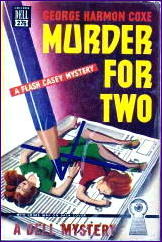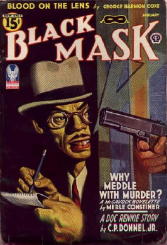Sun 7 Dec 2008
Archived Mystery.File Review: GEORGE HARMON COXE – Murder for Two.
Posted by Steve under Pulp Fiction , Reviews[2] Comments
GEORGE HARMON COXE – Murder for Two.
Dell #276; mapback edition; no date stated, but circa 1949. Hardcover edition: Alfred A. Knopf, 1943.

Another Boston mystery, this one featuring “Flashgun” Casey, ace photographer for the Express, but one of another style and another era. While Death of a Harvard Freshman [reviewed earlier here] was wordy and cerebral, this novel by George Harmon Coxe is terse and prone to violent action. Casey is as good with his fists as with his wits.
As you might have known without my saying so, had I mentioned earlier that this novel was originally published as a Black Mask serial. Its original title in the pulps? “Blood on the Lens.” [A three-part serial, beginning January 1943.]
And as far as titles go, Murder for Two is the more appropriate, even though it’s rather meager and bland in comparison. The first death is that of crusading columnist Rosiland Taylor. Apparently someone objected to a story she was working on. The second death is that of a former secretary who held some incriminating evidence against the target of that story.

The case is all so straightforward that it comes as quite a pleasant (though not unexpected) surprise to learn that Coxe has more of a mystery in mind than that, so if you pick this one up and give it a try, don’t take it too lightly as a work of detective fiction. Keep reading. (The question is more of how Coxe is going to pull off what he does, not whether.) The key here is that there is a very nifty alibi involved, one so nifty, as a matter of fact, that no one is even aware it is an alibi.
Or in other words, there is a lot of action going on in this book, so take this as a warning. Coxe’s meticulous plotting can easily blindside you and catch you as flat-footed as I was. (A humbling admission to make, but there you are.)
He also catches a rare male camaraderie between Casey and police lieutenant Logan of Homicide — one that can suddenly flare into mutual irritation and tired sarcasm but then, with common sense and good humor, just as quickly right itself back into place again.
December 9th, 2008 at 7:29 pm
[…] meant to say something about George Harmon Coxe’s “workmanlike” prose in my recent review of Murder for Two, but it could be said just about as well right here. [The phrase is a common one; […]
August 14th, 2010 at 8:51 pm
[…] by Steve Lewis) Old Time Radio: Crime Photographer [09 Nov 1950] “Woman of Mystery” Murder for Two (reviewed by Steve Lewis) Film: Here’s Flash Casey (reviewed by Steve Lewis) GEORGE HARMON […]